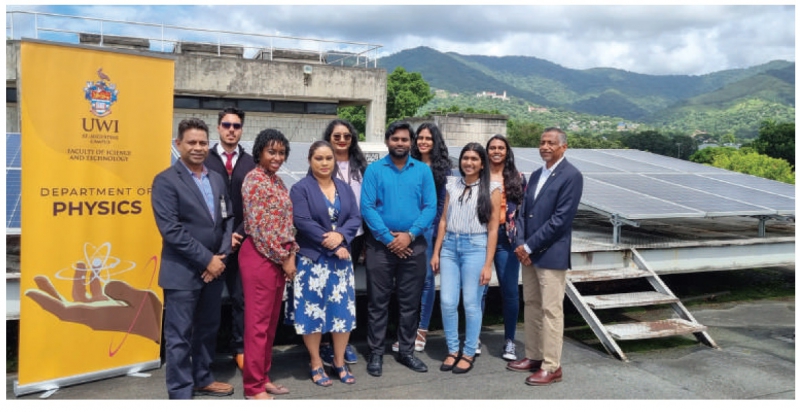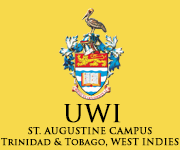Looking at Environmental Issues through a Physics lens

In the 1970s, at UWI St Augustine, against a backdrop of plentiful oil in Trinidad and Tobago, a group of lecturers from the Physics Department started research on renewable energy and renewable energy applications. These researchers included Professor Ramsey Saunders, Dr Alwyn Tang Kai, and Dr Imran Mc Doom. “Initially trained in theoretical physics and medical physics, they saw the need to initiate research in solar thermal applications such as the drying of food crops, solar distillation, and solar refrigeration,” explains Dr Ricardo Clarke, Senior Lecturer of Environmental Physics. They later developed an Environmental Physics minor in the department in the late 1980’s as part of the undergraduate curriculum. From the beginning, research in renewable energy and environmental physics has blossomed in the Physics Department. It has led to the earning of PhDs in renewable energy fields, the development of an MSc in Renewable Energy Technology, partnerships with public agencies engaged in energy or environmental services, and the establishment of the department’s Environmental Physics Lab in 2007-2008.
Grooming the next generation of renewable energy and climate scientists
The Environmental Physics Laboratory (EPL) was created to focus on not only renewable energy but also other environmental issues, such as climate change, sustainability, and resilience, with a focus on Trinidad and Tobago and the Caribbean. “This year, the Environmental Physics Lab celebrates 15 years,” says Dr Xsitaaz Chadee, lecturer in Renewable Energy and Environmental Physics. “It has had two PhD and four MPhil graduates. It continues to grow in research areas and interests and emphasises grooming the next generation of renewable energy and climate scientists.” Among that next generation are postgraduate students Nkese McShine and Mohammed Shaddy. Nkese, a PhD student, is investigating the historical variations in the wind resources and the impacts of climate change on the wind resources in the Caribbean. Mohammed, who is studying for his MPhil, is focused on wind measurements relevant to tall wind turbines. This project is part of a collaboration and involves the use of a sonic detection and ranging (SODAR) device from the Flensburg University of Applied Science in Germany.
Research work is also currently being conducted in an industry-academic partnership with Trinity Exploration and Production (Trinidad and Tobago) Limited. "This Industry-academic partnership has been instrumental in providing state-of-the-art research-grade equipment for Nalini Dookie, a PhD candidate,” explains Dr Chadee. “Measurements of the components of solar energy are being taken at high temporal resolutions to improve the projections of the annual energy outputs of photovoltaic systems.” Dr Chadee was the first PhD student from the EPL. With training at the International Centre of Theoretical Physics in Trieste, Italy and the Centre for Wind Energy in Chennai, India, she created high-resolution wind maps for Trinidad and Tobago through numerical weather prediction modelling techniques. This was the first time high-intensive computational resources were used for research work in the Physics department and the first wind energy research project specifically on wind resource assessment. In addition, Dr Chadee improved the regional wind maps for the Caribbean using global climate data sets. Together with Dr Clarke, she worked with the National Energy Corporation of Trinidad and Tobago and the Ministry of Energy and Energy Industries on developing a Wind Resource Assessment Programme for Trinidad and Tobago. This was submitted to the Green Fund in 2014.
Collaboration Essential for Environmental Physics Lab Research
According to Dr Clarke, “Collaboration is essential for most of the research projects in the Environmental Physics Lab.”
For Priscilla Sahadeo’s PhD research in solar drying of cocoa beans, much of her work is driven by Dr Darin Sukha and Professor Pathmanathan Umaharan of the Cocoa Research Centre (CRC) and under an RDI grant obtained by the CRC.
Zaffir Mohammed, an MPhil candidate, is jointly supervised by Dr Gregory Gouveia of the Department of Food Production and Dr Clarke of the Physics Department. Mr Mohammed’s research focuses on characterising expansive soils that pose a high risk in infrastructure and housing developments.
Shane Baldeosingh, whose research focuses on the impact of sea level rise on coastal areas of Trinidad, was jointly supervised with the late Professor Dave Chadee of the Department of Life Sciences.
Research projects at the EPL can also span multiple disciplines. Randy Ramadhar Singh, PhD candidate, is investigating the energy transition for Trinidad and Tobago as a unique case of a country transitioning from natural gas to including renewables and how the country can meet its nationally determined contributions to climate change in the power generation sector. The EPL has had an excellent relationship with the Meteorological Services of Trinidad and Tobago (TTMS). Data from the TTMS have been used to assess the historical trends in rainfall and temperature as well as their extreme indices and to perform pre-feasibility assessments in wind and solar resources. Sadira Khan, a recent graduate with an MPhil in Physics, used such data to develop empirical models that can help with filling gaps posed by limited solar radiation data sets.
Pioneers in Renewable Energy Research at UWI St Augustine
Faculty and students at the EPL are doing important research today; however, it would not be possible without the groundwork laid by pioneers on the campus. Dr Clarke and Dr Chadee point to a few postgraduate students in the 1990s who enrolled to study solar energy applications and did innovative work in solar timber drying and solar cooking. This not only led to PhDs in these areas but also the installation of a solar timber dryer at the University Field Station in Mt Hope. Likewise, Dr Indra Haraksingh, renowned for renewable energy and policy in the Caribbean and recently retired from the Department of Physics, developed the MSc in Renewable Energy Technology in conjunction with the Cave Hill and Mona campuses, the Flensburg University of Applied Sciences and the University of Flensburg, Germany. The MSc was launched in 2013. The Environmental Physics Lab serves as both a centre for research and a hub for mentoring and training the next generation of environmental physicists. The lab continues to nurture talent whose contributions are shaping a more sustainable and resilient Caribbean.








